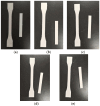FDM 3D Printing and Properties of PBAT/PLA Blends
- PMID: 38675058
- PMCID: PMC11054694
- DOI: 10.3390/polym16081140
FDM 3D Printing and Properties of PBAT/PLA Blends
Abstract
Biodegradable polylactic acid (PLA) has been widely used in fused deposition modeling (FDM) 3D printing. In order to improve its comprehensive properties in 3D printing, in this study, 0-40% content of polybutylene adipate terephthalate(PBAT) was selected to be blended with PLA in a twin-screw extruder; the resulting pellets were drawn into a homogeneous filament; then, PBAT/PLA samples were prepared by FDM 3D printing, and the effects of the dosage of PBAT on the mechanical properties, thermal behavior, surface wettability and melt flowability of the samples were investigated. The results showed that all the samples could be printed smoothly, and the ductility was slightly improved by the increase in the PBAT dosage; the thermal stability of PLA was enhanced by blending with PBAT, and the crystallinity increased monotonically with the increase in PBAT. After blending with PBAT, the surfaces of the samples were more hydrophilic and flowable. The important conclusion achieved in this work was that the PBAT/PLA blends, especially those containing 30%PBAT, showed great potential to replace petroleum-based plastics and are suitable for use in FDM 3D printing technologies for different applications.
Keywords: 3D printing; blend; fused deposition molding; poly(lactic acid); polybutylene adipate terephthalate; property.
Conflict of interest statement
The authors declare no conflicts of interest.
Figures








Similar articles
-
FDM 3D Printing and Properties of WF/PBAT/PLA Composites.Molecules. 2024 Oct 28;29(21):5087. doi: 10.3390/molecules29215087. Molecules. 2024. PMID: 39519728 Free PMC article.
-
FDM 3D Printing and Properties of PBS/PLA Blends.Polymers (Basel). 2023 Nov 2;15(21):4305. doi: 10.3390/polym15214305. Polymers (Basel). 2023. PMID: 37959985 Free PMC article.
-
Improvement of Interlayer Adhesion and Heat Resistance of Biodegradable Ternary Blend Composite 3D Printing.Polymers (Basel). 2021 Feb 27;13(5):740. doi: 10.3390/polym13050740. Polymers (Basel). 2021. PMID: 33673591 Free PMC article.
-
Binary Green Blends of Poly(lactic acid) with Poly(butylene adipate-co-butylene terephthalate) and Poly(butylene succinate-co-butylene adipate) and Their Nanocomposites.Polymers (Basel). 2021 Jul 28;13(15):2489. doi: 10.3390/polym13152489. Polymers (Basel). 2021. PMID: 34372090 Free PMC article. Review.
-
Biodegradable Poly(Lactic Acid) Nanocomposites for Fused Deposition Modeling 3D Printing.Nanomaterials (Basel). 2020 Dec 21;10(12):2567. doi: 10.3390/nano10122567. Nanomaterials (Basel). 2020. PMID: 33371307 Free PMC article. Review.
Cited by
-
Biodegradable Meets Functional: Dual-Nozzle Printing of Eco-Conscious Parklets with Wood-Filled PLA.Materials (Basel). 2025 Jun 22;18(13):2951. doi: 10.3390/ma18132951. Materials (Basel). 2025. PMID: 40649439 Free PMC article.
-
Preparation and Characterization of Triglycine-Containing 3D-Printed PBAT/PLA Specimens.ACS Omega. 2025 May 26;10(22):23817-23826. doi: 10.1021/acsomega.5c03205. eCollection 2025 Jun 10. ACS Omega. 2025. PMID: 40521449 Free PMC article.
-
Integrative Modeling and Experimental Insights into 3D and 4D Printing Technologies.Polymers (Basel). 2024 Sep 24;16(19):2686. doi: 10.3390/polym16192686. Polymers (Basel). 2024. PMID: 39408397 Free PMC article. Review.
References
-
- Kim S., Korolovych V.F., Muhlbauer R.L., Tsukruk V.V. 3D-printed polymer packing structures: Uniformity of morphology and mechanical properties via microprocessing Conditions. J. Appl. Polym. Sci. 2020;137:e49381. doi: 10.1002/app.49381. - DOI
-
- Davood R., Kianoosh S., Mostafa P., Mohammad A., Elyas S., Ismaeil G., Majid B., Karen A., Mahdi B., Mostafa B. Shape memory performance assessment of FDM 3D printed PLA-TPU composites by Box-Behnken response surface methodology. Int. J. Adv. Manuf. Technol. 2023;127:935–950.
-
- Vorkapić M., Mladenović I., Ivanov T., Kovačević A., Hasan M.S., Simonović A., Trajković I. Enhancing mechanical properties of 3D printed thermoplastic polymers by annealing in moulds. Adv. Mech. Eng. 2022;14:16878132221120737. doi: 10.1177/16878132221120737. - DOI
-
- Liu H., He H., Peng X.D., Huang B., Li J.X. Three-dimensional printing of poly(lactic acid) bio-based composites with sugarcane bagasse fiber: Effect of printing orientation on tensile performance. Polym. Adv. Technol. 2019;30:910–922. doi: 10.1002/pat.4524. - DOI
-
- Davood R., Ismaeil G., Majid B., Karen A., Mostafa B. 4D printing of PLA-TPU blends: Effect of PLA concentration, loading mode, and programming temperature on the shape memory effect. J. Mater. Sci. 2023;58:7227–7243.
LinkOut - more resources
Full Text Sources

